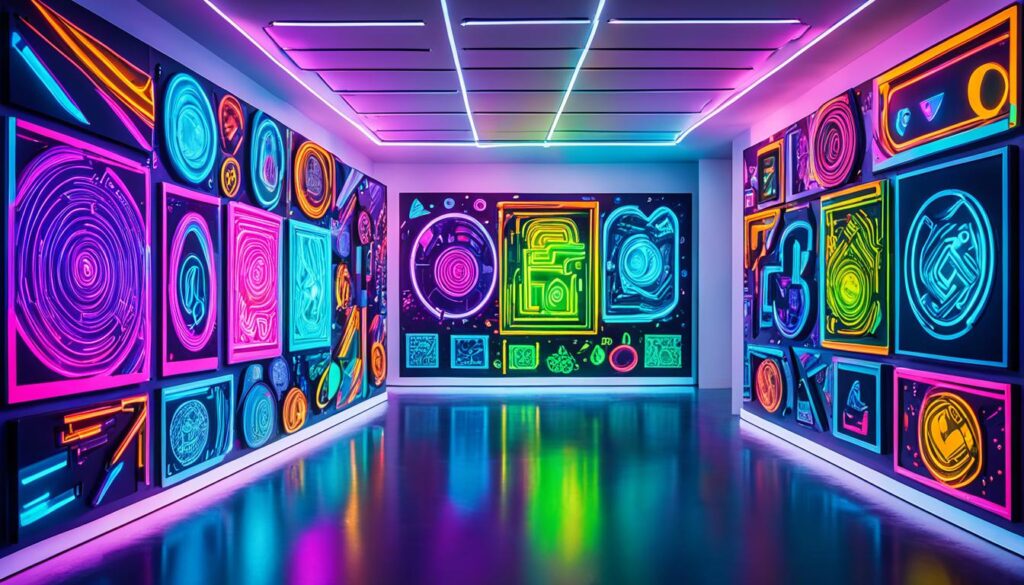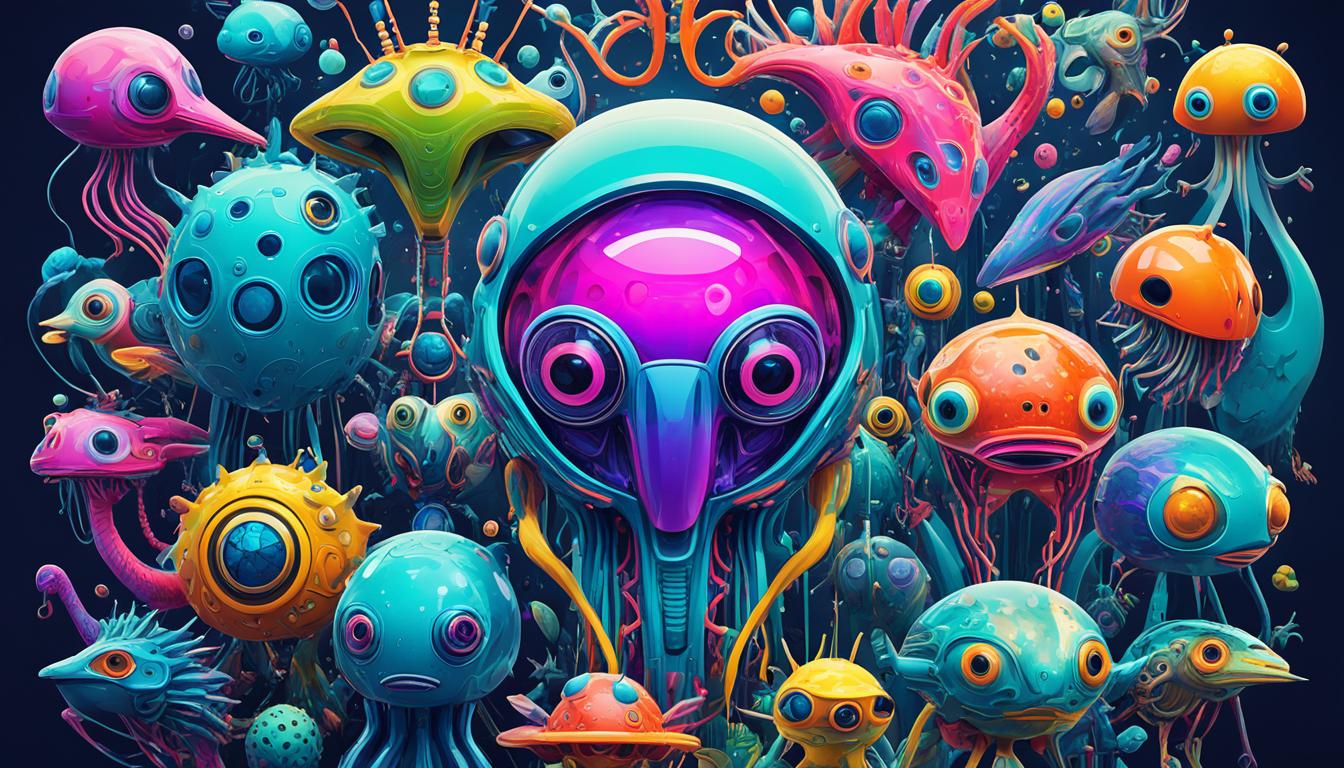Did you know that an AI-generated artwork recently sold for a staggering $69 million? Welcome to the world of AI-generated crypto collectibles, where the convergence of art and technology has revolutionized how we create, own, and trade digital art. Through the combination of generative artificial intelligence (AI) and non-fungible tokens (NFTs), a new frontier of artistic expression and financial opportunities has emerged.
Key Takeaways:
- Generative AI, using techniques like GANs, can produce unique pieces of art with commercial value.
- NFTs assign unique identities to digital artworks, ensuring authenticity and ownership in the digital realm.
- The integration of generative AI and NFTs opens up new possibilities for artists, collectors, and the overall art market.
- Artists can monetize their digital creations directly and earn ongoing royalties through NFTs.
- The convergence of AI and NFTs is reshaping the digital art market, changing how art is created, valued, and bought.
The Dawn of Generative AI in Art
Generative AI has revolutionized the landscape of art creation by introducing AI systems that can generate unique and original content, including visual art. One of the most prominent examples of generative AI in the art world is the portrait of Edmond de Belamy, created by the art collective Obvious using Generative Adversarial Networks (GANs).
This AI-generated artwork gained significant attention in 2018 when it sold for an astonishing $432,500 at Christie’s auction house. The sale of ‘Edmond de Belamy’ highlighted the potential of AI to create art pieces that hold value in traditional art markets, blurring the lines between human and AI creativity.
“AI art is not a gimmick; it is a medium that holds tremendous possibilities for artistic expression,” says renowned art critic, Sarah Anderson. “The depth and complexity of AI-generated artworks challenge our traditional notions of authorship and creativity, sparking fascinating authorship debates within the art world.”
The discussions surrounding authorship and creativity in AI-generated art have sparked ongoing debates that shape and redefine our understanding of art as technology advances. Artists, critics, and art enthusiasts continue to explore the profound implications of generative AI in the art world, questioning the role of AI systems as creators and the relationship between AI-generated art and human artistic expression.
The integration of generative AI in the art world not only presents new possibilities for creating unique artworks but also raises intriguing questions about the nature of authorship, originality, and the future of artistic creation.
The convergence of generative AI, AI systems, and art has facilitated the birth of exceptional artworks that challenge artistic conventions and invite us to question the boundaries of creativity. As the field of generative AI progresses and AI-generated art becomes more prevalent, the ongoing authorship debates and intellectual exploration will play a crucial role in shaping the future of art and technology.
Crypto Collectibles: A New Medium of Art Ownership
Crypto collectibles, also known as non-fungible tokens (NFTs), have emerged as a revolutionary form of digital art ownership.
NFTs use blockchain technology to assign unique identities to digital objects, ensuring their authenticity and ownership. This solves the long-standing issue of replicability and distribution that diminishes the value of digital artwork.
In the art world, NFTs have gained widespread acceptance, with high-profile sales such as Beeple’s ‘Everydays: The First 5000 Days’ selling for $69 million. This highlights the growing recognition of NFTs as a legitimate medium for art ownership.
What sets NFTs apart is their ability to enable artists to directly monetize their digital creations. Unlike traditional art forms, where artists often rely on intermediaries such as galleries or auction houses, NFTs provide artists with a direct revenue stream. When an NFT is resold, artists can earn ongoing royalties, ensuring a continuous flow of income from their work.
This new medium of art ownership extends the possibilities for artists, enabling them to explore digital art creation and distribution in innovative ways. By embracing NFTs, artists can tap into a global market of art enthusiasts and collectors, unrestricted by geographical limitations.
The rise of crypto collectibles also brings about a shift in the relationship between artists and their work. By embracing digital art and NFTs, artists have the opportunity to cultivate a community of supporters and engage directly with their audience. This direct connection allows for a deeper level of interaction and collaboration, fostering a sense of ownership and appreciation for the artist’s creations.
As blockchain technology continues to evolve, so does the landscape of digital art ownership. Crypto collectibles and NFTs have opened up new possibilities for artists, collectors, and art enthusiasts, reshaping the art market in unprecedented ways.

The Benefits of Crypto Collectibles and NFTs:
- Assigns unique identities to digital objects, ensuring their authenticity and ownership
- Enables direct monetization for artists through ongoing royalties
- Expands the reach of artists by tapping into a global market of art enthusiasts
- Fosters a deeper connection between artists and their audience
- Reshapes the art market and introduces new possibilities for art ownership
“Crypto collectibles and NFTs have transformed the art world, offering artists new avenues for monetization and art enthusiasts a unique way to collect and own digital artwork.” – Art Investor Magazine
The Convergence of Generative AI and Crypto Collectibles
The convergence of generative artificial intelligence (AI) and crypto collectibles is revolutionizing the art market. AI has the remarkable ability to create art on a scale and speed that surpass human artists. With the help of AI tools, artists can generate unique and mesmerizing artwork or enhance their creative process, pushing the boundaries of artistic expression.
At the same time, crypto collectibles, in the form of non-fungible tokens (NFTs), assign value to these digital creations. NFTs provide a direct and sustainable channel for artists to monetize their work, enabling them to earn ongoing royalties each time their artwork is sold or traded. This innovative technology empowers artists to explore new creative avenues while ensuring a fair and transparent system for ownership and resale.
For collectors, the convergence of generative AI and crypto collectibles opens up a vast universe of unique art pieces that would not exist without this technology. Each AI-generated artwork becomes a digitally scarce and valuable asset, backed by blockchain technology. The transparency and immutability of the blockchain guarantee the authenticity and provenance of these AI masterpieces.
This convergence marks a significant shift in the way art is created, valued, and collected. As AI continues to evolve and NFTs gain more prominence, we can expect further transformations in the art market. The fusion of generative AI and crypto collectibles paves the way for a sustainable art market where artists thrive, collectors indulge in a diverse array of digital artworks, and the art world experiences an unprecedented wave of innovation.
FAQ
What are AI-Generated Crypto Collectibles?
How does Generative AI contribute to the art world?
What is the significance of Crypto Collectibles in the art market?
How does the convergence of Generative AI and Crypto Collectibles impact the art market?
Source Links
- https://www.theverge.com/22310188/nft-explainer-what-is-blockchain-crypto-art-faq
- https://www.linkedin.com/pulse/how-generative-ai-crypto-collectibles-transforming-digital-lepisko?trk=article-ssr-frontend-pulse_more-articles_related-content-card
- https://www.linkedin.com/pulse/cognitive-benefits-ai-generated-crypto-art-vladimir-lepisko

Leave a Reply